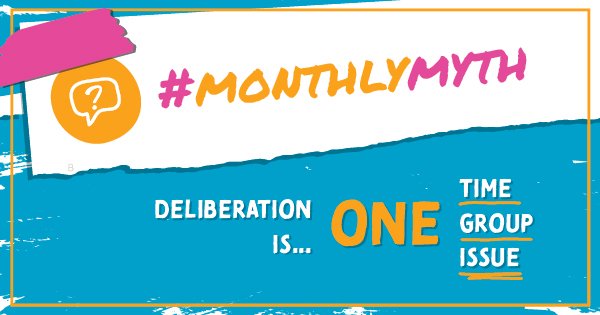Have you seen or been involved in a deliberative engagement process lately? Chances are, it involved one group of randomly selected panelists considering an issue over a short-term period (2-4 months).
This model can be very effective, and every deliberative process (if done right and built on deliberation principles) has the power to have a transformative, positive impact. However, it’s worth considering that there are other options. There are many ways to tailor this powerful form of engagement to your issue, community, organisation and desired outcomes.
It’s great to see deliberation in decision making slowly becoming the norm, not the exception. Organisations are seeking better ways to engage and do business, while also facing pressure as external expectations build around integrating deliberative practice into planning processes. And we personally know from years of engaging with the public, that genuine and high-influence engagement at the right time around an issue/topic, can yield amazing results!
This greater interest in deliberative processes has meant, over the last 5-10 years, plenty of deliberations have been popping up around Australia. A lot of what we’re seeing right now though, particularly in the government space, is deliberation done the same way.
Let’s delve into a few ideas that might inspire you and open some new possibilities in this impactful engagement space. We’re certainly feeling inspired, and we’re working with organisations on some of the ideas below right now (stay tuned for some future case studies!).
WHAT ARE THE ALTERNATIVES?
Here’s just 3 ideas for alternative models of deliberation. We’re starting with three, however we have more up our facilitator sleeves! Deliberative principles can be integrated into many different engagement approaches and the method undertaken can be shaped to ensure the process is as effective as possible.
1. Side by side
Two randomly selected groups are created based on different recruitment filters and demographic targets. One may, for example, be designed to amplify minority voices, while the other is descriptively representative of the wider community. Their recommendations can be compared across both groups.
2. Leap frog
Linking one deliberative process to the next, this is where a deliberative group ‘hands the baton’ to a new panel of randomly selected people. The power in this model is the possibility of linking deliberations over time, building on work and achievements and creating a chain of continuous learning. An extension of this is what we call ‘osmosis’, where a small group of representatives from each previous deliberative panel or jury contribute to the next deliberative group/phase.
3. Standing panel
A standing panel is a group of people that are selected to collaborate around many issues over a long period of time. For example, you might establish a panel of participants interested in participating in council activities over two years. The group weighs up issues and defines problems for the council over that period, then the group is refreshed.
HOW DO I KNOW WHAT TO CHOOSE?
Selecting the right model is where some careful, strategic thinking comes in. Defining high level parameters such as the problem/s you’re facing, the outcomes you’re hoping to achieve and the budget you have to work with is the first step and will help to guide you.
Choosing the right model is linked to methodology – the process undertaken to deliver those desired outcomes. Method design can require specialised support and that’s where facilitators and engagement practitioners come in.
Seeking professional direction and high-level advice before writing a request for tender can help. Sometimes, a specialist can help you explore the possibilities and avoid writing a brief that’s too prescriptive and doesn’t meet your needs.
WANT MORE FREE INFO?
Our website is packed with other free resources including guides, videos and publications that you can download and view right now.
Plus our FREE monthly newsletter
The Discussion shares the latest engagement news, ideas, case studies and more. Subscribe for free today.





